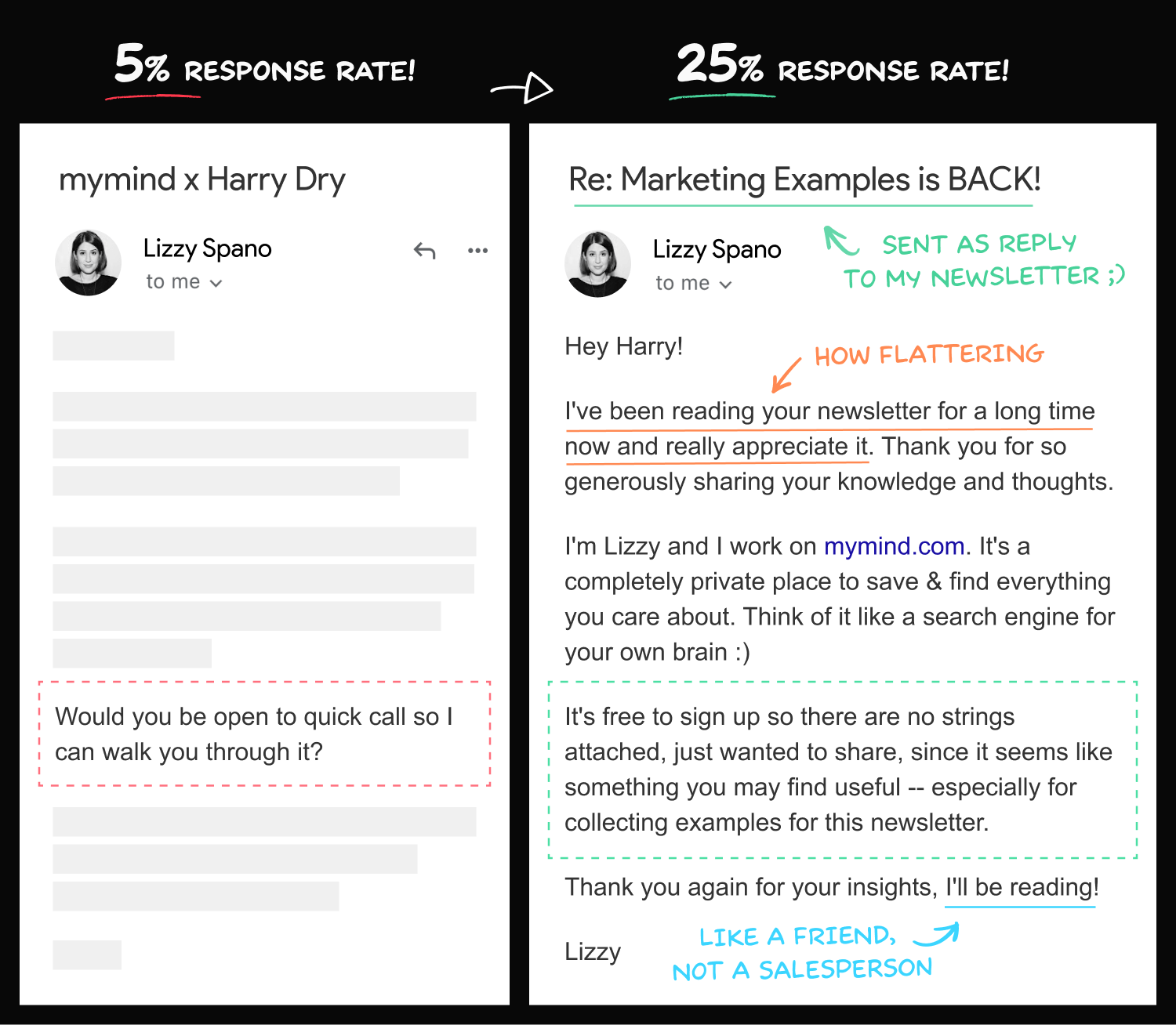Cold Email Strategy Boosts Reply Rates by 5X: The Power of Not Asking
Discover how a subtle shift in cold email strategy, removing the ask, boosted reply rates by 5X. Learn why a no-pressure approach gets better results.
Harry receives a lot of emails. In fact, last month, his inbox was flooded with 97 cold emails. Ninety-seven pitches from people asking for his time, attention, or interest in their product. He ignored almost all of them.
But one email stood out. One email got a reply.
And it wasn’t because it had a flashy subject line or an irresistible offer. It was because it didn’t ask for anything at all.
Why Most Cold Emails Fail
Harry has seen it all. The cold emails that hit his inbox follow the same tired formula:
- “Can I grab 15 minutes of your time?”
- “We have an amazing product you’ll love!”
- “Just following up on my previous email…”
These emails all have one thing in common: they’re trying to take something from him. His time, his attention, or his trust, none of which he’s willing to give without good reason.
It’s not that Harry doesn’t want to engage. He loves connecting with interesting people and exploring great ideas. But the problem is these emails all feel the same, and the immediate ask creates resistance.
That’s why most of them end up deleted.
The One Email That Worked
The only email Harry replied to came from someone named Lizzy.
What made her email different?
- She didn’t ask for a meeting.
- She didn’t try to sell anything.
- She didn’t even ask for a reply.
Instead, Lizzy started her email with something simple but powerful: genuine appreciation.
Her email began like this:
📩 "I’ve been reading your newsletter for a long time now and really appreciate it. Thank you for sharing your knowledge."
That was it. No agenda, no push.
After a brief introduction to what she worked on, she mentioned her product casually, almost as an afterthought. She even included a link but didn’t frame it as a “must-click.”
And the most remarkable part? Instead of ending with a hard call to action like “Let’s schedule a call”, Lizzy closed her email with:
📩 "I’ll be reading!"
It was warm, friendly, and human. No pressure, no demands.
And because of that, Harry did something he rarely does: he clicked the link. He explored Lizzy’s work on his own terms, and in return, he replied to her email.

Why This Approach Worked
Lizzy later shared the secret behind her strategy:
“I stopped asking for a quick call and clarified I wasn’t asking for anything. Responses went from 5% to 25%.”
This small adjustment transformed her outreach. And it worked for three key reasons:
1. It Removed Resistance
Cold emails usually create friction. The recipient’s first instinct is to protect their time and avoid being sold to.
But Lizzy’s email disarmed Harry. There was no ask, no pitch, just a friendly note. Because there was no pressure, there was no reason to ignore it.
2. It Built Trust
Before Lizzy mentioned her work, she made it clear that she valued Harry’s. She opened with genuine appreciation, which immediately set a positive tone.
Instead of feeling like a target, Harry felt like Lizzy saw him as a person. That trust made all the difference.
3. It Invited Curiosity
Because Lizzy wasn’t pushy, Harry wanted to learn more. By casually mentioning her product and leaving it at that, she made it easy for him to explore her work without feeling obligated.
How Others Can Learn From This
Lizzy’s approach is more than just a cold email strategy, it’s a lesson in how to communicate effectively in a crowded, noisy world. Here’s how anyone can apply it to their own outreach:
1. Start With Genuine Appreciation
- Do your homework. Reference something specific about the person’s work or achievements.
- Be authentic. Flattery only works if it’s sincere.
- Show that you respect their time.
2. Introduce What You Do, Briefly
- Keep it casual. Focus on creating curiosity, not pushing an agenda.
- Avoid jargon or over-explaining. Less is more.
- Frame it as something the recipient might find interesting, not something they must check out.
3. End With a Light, No-Pressure Sign-Off
- Replace aggressive CTAs with softer alternatives like:
- “Just wanted to share, hope you find it helpful.”
- “No need to reply, just thought you might like this.”
- “Would love to hear your thoughts if you ever check it out!”
By not asking for a reply, you often increase your chances of getting one.
What This Means for Cold Emailing
There’s a common belief in sales: “Don’t ask, don’t get.”
But Lizzy’s story suggests the opposite. In some cases, don’t ask, and you’ll get more.
By removing the pressure, she made it easy for Harry to engage on his own terms. And that small change turned a cold email into a warm connection.
The lesson? Sometimes, the most effective way to get someone’s attention isn’t by asking for it, it’s by giving them space to choose. # The Cold Email Hack That Got Harry to Reply
When we're drowning in cold emails, it takes something truly different to stand out. Most emails follow a predictable formula, introduce the sender, make a request, and end with a pushy call to action. And like most people, Harry had grown immune to these predictable pitches.
